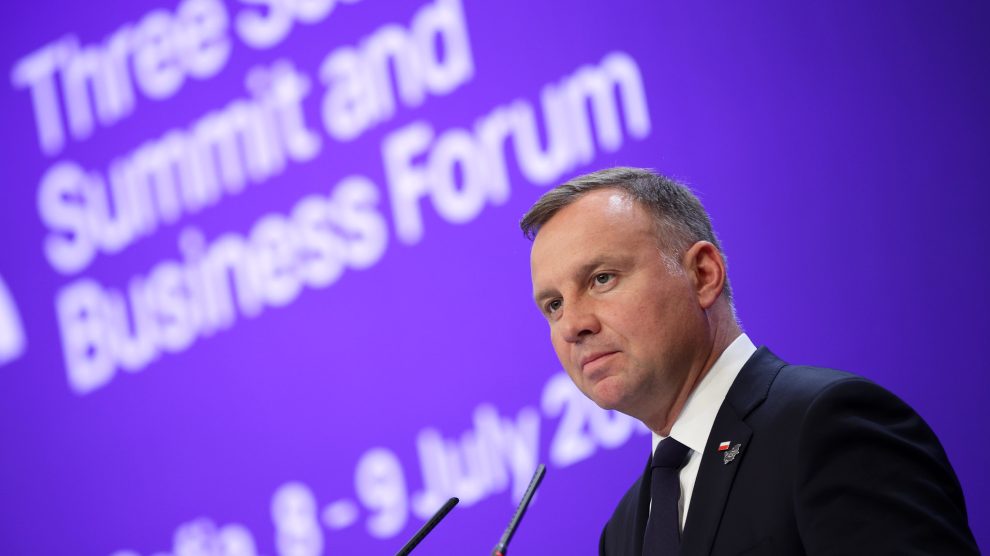The Three Seas Initiative currently lacks the political backing that would see it given the leadership and financial support it needs to gain any real momentum, but similarly lacks anyone brave enough to call time on its existence.
Romanian President Klaus Iohannis, whose public appearances have become few and far between as he approaches the end of his second term in office, will make a return to the international stage in September when he hosts the eighth summit of the Three Seas Initiative (3SI) at his official residence in Bucharest.
Joining Iohannis will be leaders from the 11 other 3SI members (Austria, Bulgaria, Croatia, Czechia, Estonia, Hungary, Latvia, Lithuania, Poland, Slovakia, and Slovenia) who are once again likely to talk up the initiative and its potential to improve transport, energy, and digital infrastructure links between member states.
Ukraine, perhaps in the shape of President Volodymyr Zelensky, who has yet to visit Romania since Russia’s invasion of his country, will also be present, alongside representatives from the US, UK and EU.
- It’s time for the EU and Three Seas Initiative to align their goals
- As more CEE countries embrace Taiwan, the 3SI could be key to even greater engagement
- The 3SI: Europe’s most critical regional cooperation initiative must succeed
There will, however, be little talk in Bucharest of the 3SI’s achievements since its inception in 2016, given that these have been few and far between. A much-hyped 3SI investment fund has attracted relatively little capital, limiting its investments to small scale projects such as a stake in the Bulgarian port of Burgas, some renewable energy capacity in Poland and a data centre in Estonia.
Infrastructure super-highways connecting the region these are not.
“Capital commitment to the 3SI’s investment fund remains below the original target of five billion euros, while member states are showing different levels of interest, at least when it comes to financially investing in the initiative,” says Dominik Istrate, senior analyst for Central and Eastern Europe at Aretera Public Affairs, a think tank.
Indeed, that the 3SI continues to exist at all can be put down to inertia. It lacks the political backing that would see it given the leadership and financial support it needs to gain any real momentum, but similarly lacks anyone brave enough to call time on its existence. It will likely continue to hold its annual summit without making any real dent in its to-do list.
“I believed that the 3SI would by now have a strong case and would develop as a true eastern EU initiative. However, there are hardly any projects and very little money involved,” says Mario Holzner, director of the Vienna Institute for International Economic Studies (wiiw), who suggests that capacities may not to exist to establish a proper regional initiative, “as all efforts are geared towards absorbing EU funds”.
Christopher Hartwell, professor of international business policy at the Zurich University of Applied Sciences School of Management and Law, calls the 3SI an “alphabet soup” of countries which share a common heritage but whose aspirations are different.
“Getting countries as diverse as Slovenia and Latvia to agree on things related to a broader, somewhat artificial ‘region’ was always a hard sell,” he says.
Good intentions
Originally launched by Polish President Andrzej Duda and his then Croatian counterpart Kolinda Grabar-Kitarović, the 3SI aims to facilitate the development of energy, infrastructure, and investment ties among the 12 member nations while strengthening trade and political cooperation among countries bordering the Adriatic, Baltic and Black seas.
Together, the 12 countries in the 3SI account for almost 30 per cent of European Union territory and 22 per cent of its population, but only for about 14 per cent of its GDP.
One of the reasons for this low percentage is the current state of infrastructure connecting the 12 countries: most infrastructure in the region runs east to west, stymieing greater regional trade and cooperation. The 3SI was created to improve infrastructure by harnessing private investment and maximising the critical role of the private sector and financial institutions in ensuring targeted, long-term investment.
“But what can the 3SI bring to the table that the private sector or other multilaterals cannot?,” asks Hartwell. “And why does there need to be an inter-governmental organisation that pushes along specific connections anyway?”
From a greater foreign policy perspective, the 3SI can and should offer the US and Europe an alternative engagement model to the Chinese Belt and Road Initiative in Central Europe and Beijing’s dwindling 17+1 cooperative development framework. Little of this has so far happened. China has been all but banished from much of Central Europe but the 3SI has been unable to fill the vacuum.
As one Bucharest-based diplomat from a 3SI country puts it, “there are relatively senior staff at our embassy who have never heard of [3SI]. It will no doubt be the number one item on our agenda for a few days during the summit and then is likely be quickly forgotten.”
Going forward, this attitude will need to change. “The future success of the 3SI requires a higher level of political will and financial commitment from all of its member states, not only from Poland and Romania (the fund’s largest regional investors),” suggests Istrate.
The reconstruction of Ukraine
Russia’s invasion of Ukraine has created an opportunity for the 3SI to put itself at the forefront of reconstruction efforts and Ukraine—which was made a ‘participating partner’ of the initiative at its 2022 summit in Riga; full membership is the privilege of EU members only—could offer the 3SI a path towards relevance. Better infrastructure links will be key to the country’s integration with its western neighbours—not to mention its future security.
“The initiative’s overall goal of securing investment in cross-border transport, energy and infrastructure projects to finally close the regional development gap is exactly what CEE needs in the wake of Russia’s continuing war,” says Istrate.
Professor Hartwell agrees, but notes that first, the war must end.
“The 3SI might have a role in terms of being on the front lines of Ukraine’s reconstruction, and bringing Ukraine into better connectivity with the eastern frontier of the EU, but that really cannot begin until the war is over,” he says.
“That would be its biggest contribution, to help connect Ukraine and Moldova, but again this is something that will be difficult to do with Russian missiles still raining down.”

An organisation in need of leaders?
One major criticism that has long been thrown at the 3SI since its creation is its lack of leadership.
It has no public face, no administration, no champion to travel the world drumming up interest and investment. This is quite deliberate: several member states fear that a formal leadership structure could quickly become unwieldy and even construed as competition for (or an alternative to) the European Union.
“Strengthening the 3SI may mean adding an institutional element: a secretary general elected by its member states, and/or establishing an annually rotating presidency with a clear programme and deliverables,” says Istrate.
“However, this can bring benefits only as long as the institutional nature remains true to the 3SI’s original goal of raising investment and does not take on an EU-sceptic element,” and notes that, “in the short term, its institutionalisation remains unlikely.”
This will no doubt come as a blow to Romania’s President Iohannis, who has for some time been scouting Europe—unsuccessfully—for a suitably senior international job to slip into when he leaves office in December.
Istrate remains bullish about the 3SI’s future, however. “Despite recent setbacks, it remains a highly promising CEE initiative and the only regional cooperation format that unites all of the region’s EU member states, helping to better position CEE on the world’s investment stage at a time of geopolitical and economic uncertainty.”
Professor Hartwell is more circumspect.
“I’m not optimistic. I think of things like the Black Sea Trade and Development Bank, which I thought was a clever way to finance infrastructure but really is a small player and just a development bank. Perhaps the 3SI will go in that direction, because I really can’t see it taking on anything of more importance.”
Photo: Polish President Andrzej Duda at a 3SI summit in 2021. © Bulgarian News Agency/3SI
Unlike many news and information platforms, Emerging Europe is free to read, and always will be. There is no paywall here. We are independent, not affiliated with nor representing any political party or business organisation. We want the very best for emerging Europe, nothing more, nothing less. Your support will help us continue to spread the word about this amazing region.
You can contribute here. Thank you.







Add Comment